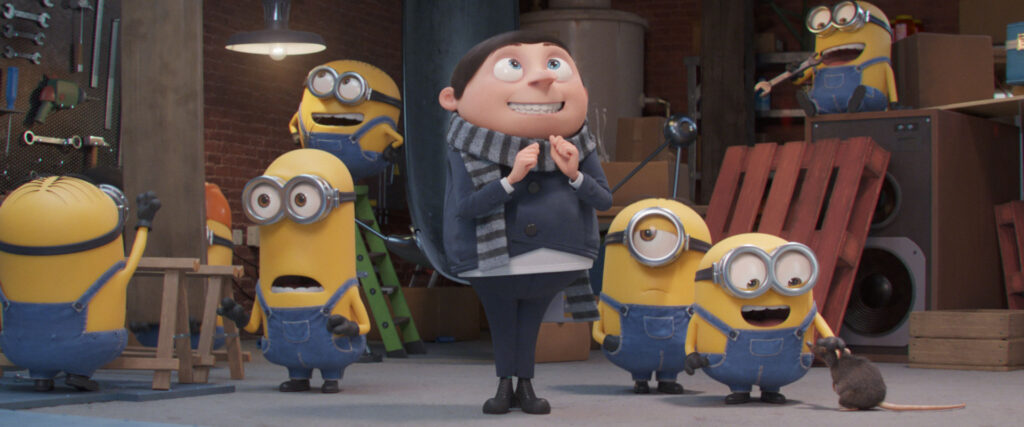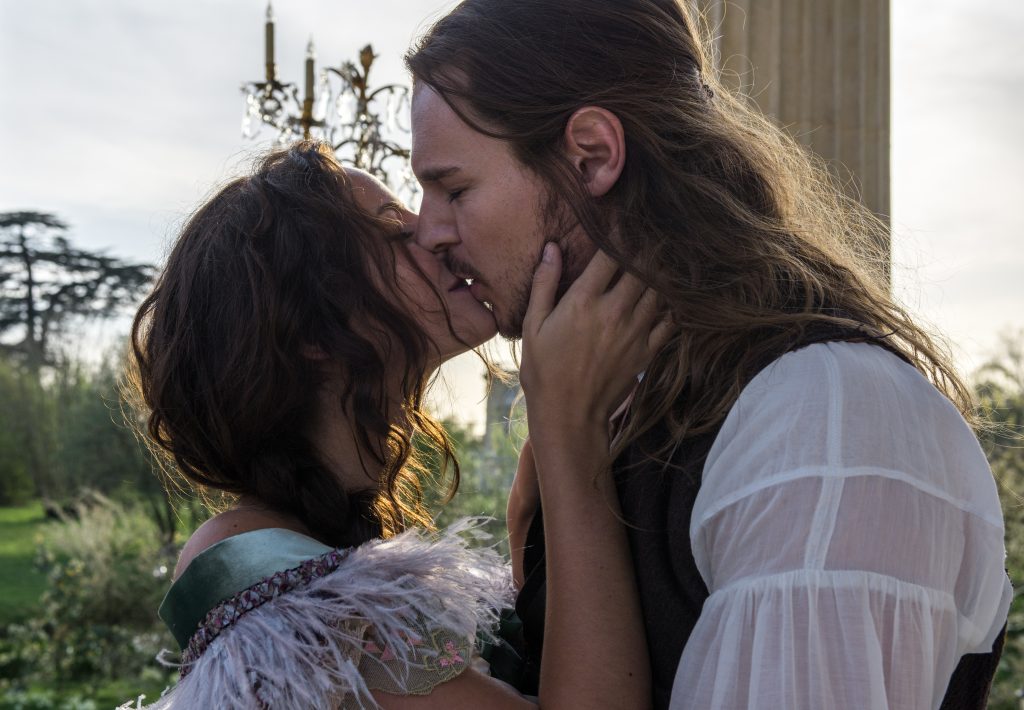June 29, 2022
by Carla Hay

Directed by Kyle Balda
Culture Representation: Taking place in the 1979, in San Francisco and in the fictional U.S. city of Springfield, California, the animated film “Minions: The Rise of Gru” features a predominantly white cast of characters (with a few African Americans, Asians and Latinos) representing the working-class and middle-class.
Culture Clash: In this origin story of “Despicable Me” supervillain Gru, he is an 11-year-old child who gets into conflicts with the Vicious 6, a gang of criminals that Gru admires.
Culture Audience: “Minions: The Rise of Gru” will appeal primarily to fans of the “Despicable Me” and “Minions” films, but others might be less charmed by the scattershot and uninspired plot of “Minions: The Rise of Gru.”

“Minions: The Rise of Gru” is an unfortunate example of how a villain origin story loses its edge when it’s about the villain’s childhood. This formulaic cartoon is nothing more than a hyper mishmash of uninspired scenes with stale jokes and very little suspense. The best movie villains are those who keep people guessing on what they’re going to do next. That’s not the case with any of the villains in “Minions: The Rise of Gru.”
Gru (voice by Steve Carell) is now just a predictable grouch, where all he really does to show his villainous side in “Minions: The Rise of Gru” is get annoyed with the Minions, the cutesy yellow mini-creatures that don’t talk like humans but spew noises that sound like a combination of chirping and computer blips. Pierre Coffin is the voice of the Minions in “Minions: The Rise of Gru.” Just as the name suggestions, the Minions are at the beck and call of Gru.
Gru (an easily agitated, on-again/off-again villain) was first seen in the 2010 animated film “Despicable Me,” which spawned the sequels “Despicable Me 2” (released in 2013), “Despicable Me 3” (released in 2017) and the spinoff-prequel “Minions,” which was released in 2015. “Despicable Me 4” is expected to be released in 2024. In all of the “Despicable Me” movies, Gru is an adult who is an ex-supervillain who doesn’t particularly like people. In “Minions: The Rise of Gru” (directed by Kyle Balda and written by Matthew Fogel), Gru (still voiced by Carell) is an 11-year-old brat. Brad Ableson and Jonathan del Val co-directed “Minions: The Rise of Gru.”
“Minions: The Rise of Gru” has a simple plot, but it’s so cluttered with disjointed scenes that it just becomes a hodgepodge of characters running around, sometimes while they’re being chased and occasionally cracking some very unfunny jokes. The child version of Gru is not someone who has any cunning wit or hilarious barbs that define who Gru is as an adult. He’s just a basic annoying kid that has been seen in numerous types of animated and non-animated movies aimed at families.
The essential plot of “Minions: The Rise of Gru” is that Gru steals something from a famous gang he wants to join, lot of chases ensue, and you can predict the end. Gru, who is an only child, lives with his unnamed single mother (voiced by Julie Andrews) in the fictional city of Springfield, California. People know that Springfield is in California because much of the action in the movie takes in San Francisco. The time period is circa 1979, based on the movie soundtrack’s overload of disco songs that were released in or a few years before 1979.
Don’t expect Gru’s mother to be big part of the story. She’s only in a few scenes, such as an early scene where Gru coms home to find his mother in a yoga session with a physically fit, young male yoga instructor. Later, when Gru gets kidnapped, he tells his abductors that it will be a waste of time to demand a ransom. “My mom will probably pay you to keep me.” It’s one of few barely funny lines in the movie.
Gru hangs out with lots of Minions, of course. The ones that get most screen time are named Otto, Kevin, Stuart and Bob. Otto, who wears teeth braces, is a people-pleasing new character introduced in this movie. Because Gru is such an unpleasant child, he has no friends. The Minions are the only beings that keep him company. Gru spends most of his time being bossy to the Minions.
Gru is a big fan of a famous criminal gang called the Vicious 6. They are led by a Wild Knuckles (voiced by Alan Arkin), a cantankerous senior citizen who is known for his fighting skills in several athletic disciplines, such as karate, boxing and jiu jitsu. The other members of the group have their own ways of fighting.
Belle Bottom (voiced by Taraji P. Henson) has a chain belt that she can make into a deadly disco ball of mace. Stronghold (voiced by Danny Trejo) has metal fists. Jean Clawed (voiced by Jean-Claude Van Damme) has a lobster claw for one of his hands. Sevengeance (voiced by Dolph Lungren) is a roller skating champ who uses his spiked skates as a weapon. Nun-Chuck (voiced by Lucy Lawless) is dressed as a traditional nun, which allows her to hide her signature weapon of nunchucks.
Through a series of events, Gru meets the Vicious 6 and asks to join their group. He’s emotionally crushed when they essentially dismiss Gru. Belle Bottom tells Gru during this rejection: “Evil is for adults, not tubby little punks who should be at school.”
Gru steals the Vicious 6’s most valuable possessions: the Zodiac Stone. Otto replaces it with a Pet Rock. And you know what that means: The Vicious 6 is out to get Gru and his Minions crew. Wild Knuckles is then ousted from the Vicious 6, which is just a lazy way for the movie to have two factions of villains instead of just one. And since Wild Knuckles is the Vicious 6 villain whom Gru admires the most, get ready for the predictable “grandfather figure to Gru” story arc that you can see coming long before it starts.
Along the way, the Minions end up in San Francisco to get karate lessons from a former karate champ named Master Chow (voiced by Michelle Yeoh), which lead to mildly entertaining but entirely formulaic scenes. An unnamed motorcycle rider (voiced by RZA) and a young Nefario (voiced by Russell Brand) have brief appearances that are mostly forgettable. Nefario is an evil inventor who is an elderly man in the “Despicable Me” movie, but his origin story is “Minions: The Rise of Gru” so weak and underdeveloped, Nefario might as well have not been in the movie.
There’s nothing wrong with any of the visuals or voice acting in this movie. The screenplay and overall direction just make everything so mind-numbingly trite. “Minions: The Rise of Gru” will make a lot of “Despicable Me” franchise fans want the adult Gru back. This child Gru needs to back to his room. Gru’s bratty pouting and whining are just one giant bore, making “Minions: The Rise of Gru” a step down for the “Despicable Me”/”Minions” series.
Universal Pictures will release “Minions: The Rise of Gru” in U.S. cinemas on July 1, 2022. The movie was first released in several other countries, beginning in Australia, on June 16, 2022.


